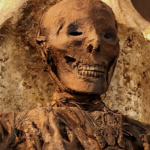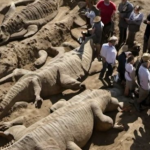Colossal Pharaohs Unearthed: Howard Carter’s 1920s Discovery of Gigantic Mummies in Egyptian Tomb
- mystery
- June 12, 2024

In the early months of 1923, Carter and his team were meticulously excavating in the Valley of the Kings, hoping to uncover more treasures and secrets from Egypt’s ancient past. The discovery of Tutankhamun’s tomb had already cemented Carter’s legacy, but fate had another extraordinary surprise in store.
One hot afternoon, as the team was surveying an area close to the tomb of Amenhotep III, a worker’s pickaxe struck something solid. The sound resonated differently than the usual echoes of rock and sand. Intrigued, Carter instructed the team to dig carefully. As the excavation progressed, they revealed the entrance to a previously unknown tomb, its sealed doorway marked with unusual hieroglyphs and symbols.

Upon breaking the seal and entering the tomb, Carter and his team were greeted by an awe-inspiring sight: a vast chamber filled with the grandeur of ancient Egypt. Colossal statues lined the walls, and golden artifacts gleamed under the light of their torches. At the center of the chamber lay two massive sarcophagi, each adorned with intricate carvings and precious stones.
The hieroglyphs on the sarcophagi identified the occupants as Pharaohs Akhenaten and Smenkhkare, rulers from the 18th Dynasty. What set these mummies apart was their size. Unlike any mummies previously discovered, these pharaohs were of gigantic proportions, standing nearly 12 feet tall.
The discovery of the Giant Pharaohs posed numerous questions and challenges. How had these enormous rulers come to be? Were they part of a lost lineage or a symbol of divine power? The hieroglyphs within the tomb provided some clues, depicting scenes of the pharaohs engaging in ceremonial rites, their towering forms accentuated to convey their god-like status.

Carter’s excitement was palpable as he began to unravel the mysteries of the Giant Pharaohs. Detailed inscriptions revealed that Akhenaten and Smenkhkare were revered as living gods, their exaggerated stature symbolizing their divine right to rule. The ancient Egyptians, known for their artistic expressions and symbolic representations, may have intentionally portrayed these pharaohs as giants to emphasize their importance and power.
The mummies themselves were marvels of preservation. Wrapped in layers of fine linen, they were adorned with golden masks and jewelry of unparalleled craftsmanship. Advanced imaging techniques of the time revealed that the mummification process had been meticulously executed, preserving even the most delicate features of these extraordinary rulers.

News of the discovery spread rapidly, capturing the world’s attention and sparking debates among scholars and historians. Some speculated that the Giant Pharaohs were a result of ancient genetic experimentation or a lost race of towering humans. Others believed it was a symbolic representation taken to unprecedented extremes.
As Carter and his team continued their work, they uncovered more artifacts and scrolls that shed light on the reign of Akhenaten and Smenkhkare. These findings included texts that detailed their contributions to Egyptian society, religious reforms, and their enigmatic worship of the Aten, the sun disk deity.
The discovery of the Giant Pharaohs added a new dimension to the understanding of ancient Egyptian civilization. It highlighted the lengths to which the Egyptians went to immortalize their rulers and cement their legacies. The tomb of the Giant Pharaohs, with its grand scale and exquisite artifacts, became one of the most significant archaeological finds of the century.
Howard Carter’s legacy, already secured by the discovery of Tutankhamun, was further solidified by this remarkable find. The Giant Pharaohs of Egypt, towering symbols of a civilization’s grandeur, continue to fascinate and inspire, reminding us of the endless mysteries that history holds, waiting to be unearthed from the sands of time.











